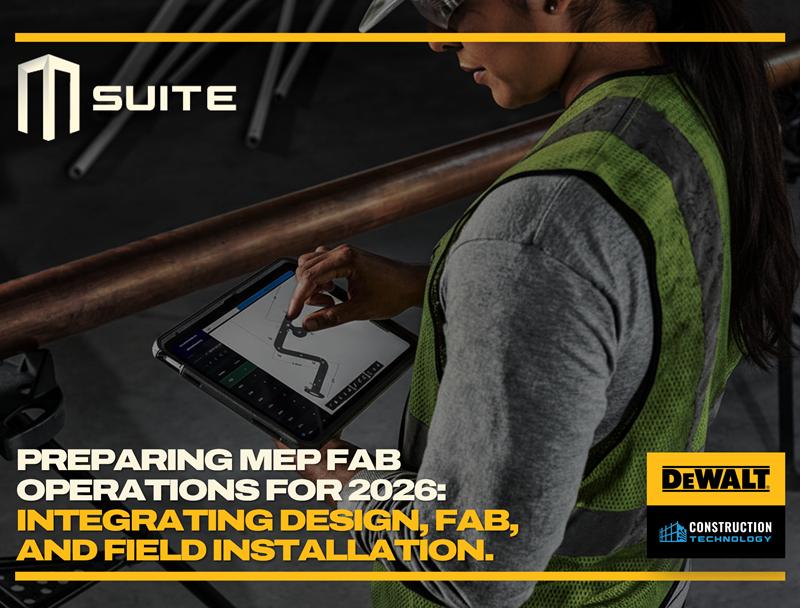Integrating Design, Fabrication, and Field Installation
The construction industry is entering a new phase of digital maturity. As 2026 gets closer, mechanical contractors deal with labor shortages, shorter project timelines, and higher expectations from owners. MCAA members across the country recognize one consistent challenge: projects now demand seamless coordination from design through field installation.
Contractors that align their design, fabrication, and field workflows will not only survive the market shift, but they will also lead it.
Why 2026 Matters for Fabrication Strategy
Industry research points to a rapid evolution already underway. McKinsey predicts that using digital tools in construction can increase productivity by 60 percent. It can also lower project costs by 20 percent.
The 2025 MCAA Fabrication Conference reinforced this direction. Contractors expanding prefabrication capacity and standardizing digital workflows are delivering projects 25 to 40 percent faster with higher installation quality.
By 2026, companies that use a single digital system for design, fabrication, and field processes will perform better. We compare this to those that rely on separate systems or manual workflows.
The Challenge: Fragmented Workflows Slow Progress
Too many fabrication shops still operate in silos on construction projects. Project Design teams model in one environment, the shop runs from spreadsheets, and field crews rely on paper updates. The lack of integration creates problems that ripple across every stage:
- Lost time from manual spooling or incomplete drawings
- Miscommunication between BIM, fabrication, and construction site installation teams
- Poor visibility into shop throughput, labor, or materials
- Delays caused by outdated data or missing change documentation
Each breakdown increases risk and reduces profitability. An old drawing or wrong hanger detail can waste hours of rework and weeks of lost progress for the project.
Integrating the Design-to-Fab-to-Field Workflow
A connected workflow links people, processes, and technology to eliminate redundancy and ensure accuracy across every stage of work. The strongest 2026 fabrication operations align three pillars:
- Design Stage: Digital-First Coordination
BIM modeling sets the foundation for fabrication success. MSUITE BIM changes Revit model data into ready-to-use information. It automates spool sheets, weld maps, and material lists right in the design area. A connected design process ensures:
- Consistent part naming and system tagging
- Automatic spool creation that eliminates repetitive modeling
- Fabrication-ready deliverables with precise alignment to field needs
The result is predictable scheduling, clear documentation, and a repeatable process that minimizes coordination errors.
- Fabrication Stage: Automation and Accountability
In 2026, fabrication shops must achieve complete visibility across workstations, materials, and labor. MSUITE FAB offers a live production dashboard. This tool helps contractors plan their work, track output, and compare performance at different sites.
Automation replaces manual reporting and helps managers make better decisions. Fabrication leaders can view:
- Work-in-progress by system, zone, or schedule priority
- Labor hours, throughput, and performance per employee
- Rework rates, quality control, and delivery status
Benchmarking key fabrication KPIs—throughput, labor utilization, rework percentage, and install readiness—builds a foundation for continuous improvement.
Research from Dodge Construction Network shows that companies using digital workflows and better analytics have much better project results. One SmartMarket Insight found that projects with high lean-construction intensity were three times more likely to finish early. They were also twice as likely to stay under budget compared to projects with low lean intensity.
- Field Stage: Install with Confidence
Installation remains the final measure of coordination. Field teams need access to the latest fabrication drawings, hanger details, and delivery updates.
MSUITE FAB’s field view connects installers to important information. This makes sure that every team member uses the same source of truth. This visibility reduces downtime from missing materials or old updates. Supervisors can plan labor with accuracy and view real-time fabrication progress.
When field data returns to the BIM environment, it shows the actual conditions. This closes the feedback loop. It improves design accuracy and efficiency for every future project.
Accelerating Field Installation with MSUITE HANGERS and DEWALT TOUGHWIRETM
Integration does not end at the shop floor. MSUITE HANGERS and DEWALT TOUGHWIRETM extend digital coordination directly to the field, helping contractors install faster and with greater consistency.
MSUITE HANGERS automates hanger layouts inside Revit, connecting placement data directly to fabrication and field workflows. It simplifies support system modeling and ensures every hanger aligns precisely with design intent. Learn more:
Once hangers reach the field, DEWALT TOUGHWIRETM enables crews to complete installations up to three times faster than traditional strap or rod systems—about three minutes per hanger versus thirteen. The system requires fewer tools, generates less material waste, and supports easy post-install adjustments when conditions change.
Together, MSUITE HANGERS and DEWALT TOUGHWIRETM connect the digital and physical worlds of construction. From model-driven hanger coordination to faster field installs, contractors gain measurable labor savings and greater reliability on every project.
The New Standard: Integrated Fabrication Operations Intelligence
Forward-thinking contractors are not simply digitizing individual tasks. They are leveraging fabrication intelligence, where design accuracy, production performance, and field progress inform one another.
An integrated workflow eliminates redundant steps, unifies communication, and enables proactive decision-making.
Contractors using MSUITE across BIM, FAB, and Field report measurable gains, including:
- 74 percent reduction in spool time
- 40 percent improvement in fabrication throughput
- Substantial reduction in rework and field clashes
These results are documented in multiple customer case studies, including Bassett Mechanical’s digital transformation with MSUITE.
Industry leaders are observing the same trend. DPR Construction reported a 90 percent drop in rework and punch-list items. This happened when they used prefabrication with standard digital workflows in complex settings. Source
These findings show how connected construction software like MSUITE helps with coordination, precision, and schedule control. This is important for high-stakes projects like data centers, hospitals, and manufacturing facilities. In these projects, quality and delivery speed are key to profitability.
The ROI of Digital Integration
The financial case for digital integration grows stronger each year. Mechanical contractors that connect their design, fabrication, and field systems see:
- Faster shop throughput with fewer errors and change orders
- Reduced administrative time for spooling, scheduling, and reporting
- Improved material management and real-time procurement visibility
- Higher labor productivity per linear foot fabricated
When data flows smoothly from the model to the shop and then to the job site, it creates opportunities. Each project can be a chance to measure, compare, and improve.
Steps to Prepare Your Fabrication Operation for 2026
- Audit your workflow: Map how information moves from design to fabrication to installation. Identify manual steps that cause delays.
- Unify your data environment: Replace spreadsheets with connected, automatically updating dashboards.
- Digitize your spooling: Automate spool creation and documentation inside Revit to reduce repetitive modeling work.
- Connect your teams: Ensure the shop and field operate from the same live data through integrated communication tools.
- Benchmark your performance: Use MSUITE Analytics to track KPIs like labor hours, throughput, and material usage.
- Invest in training: Prepare your workforce for AI-assisted tools that enhance craftsmanship and productivity.
By addressing both the technological and human sides of digital transformation, contractors can move into 2026 with confidence.
Building the Fabrication Shop of the Future
The next generation of mechanical construction will reward those who build connected, data-driven operations. Contractors that combine design, fabrication, and field installation into one system will complete projects faster and safer. They will also achieve higher profits.
MSUITE helps contractors improve every part of their workflow. It turns BIM models into real products. It also gives full visibility from the shop floor to the final installation.
To see how MSUITE can prepare your operation for 2026, see a live demo.









